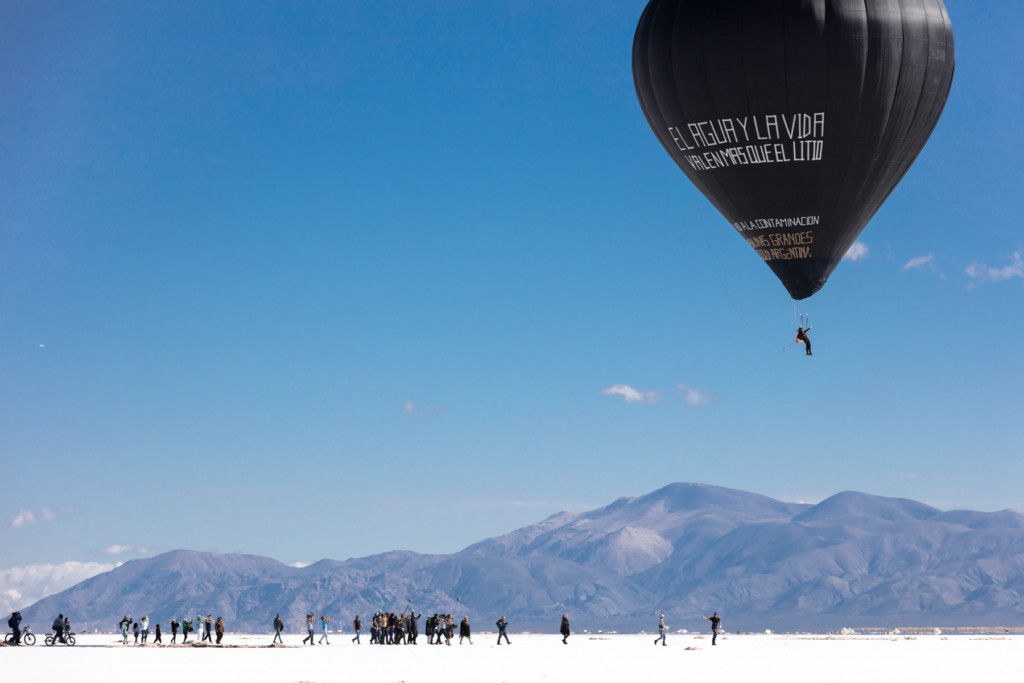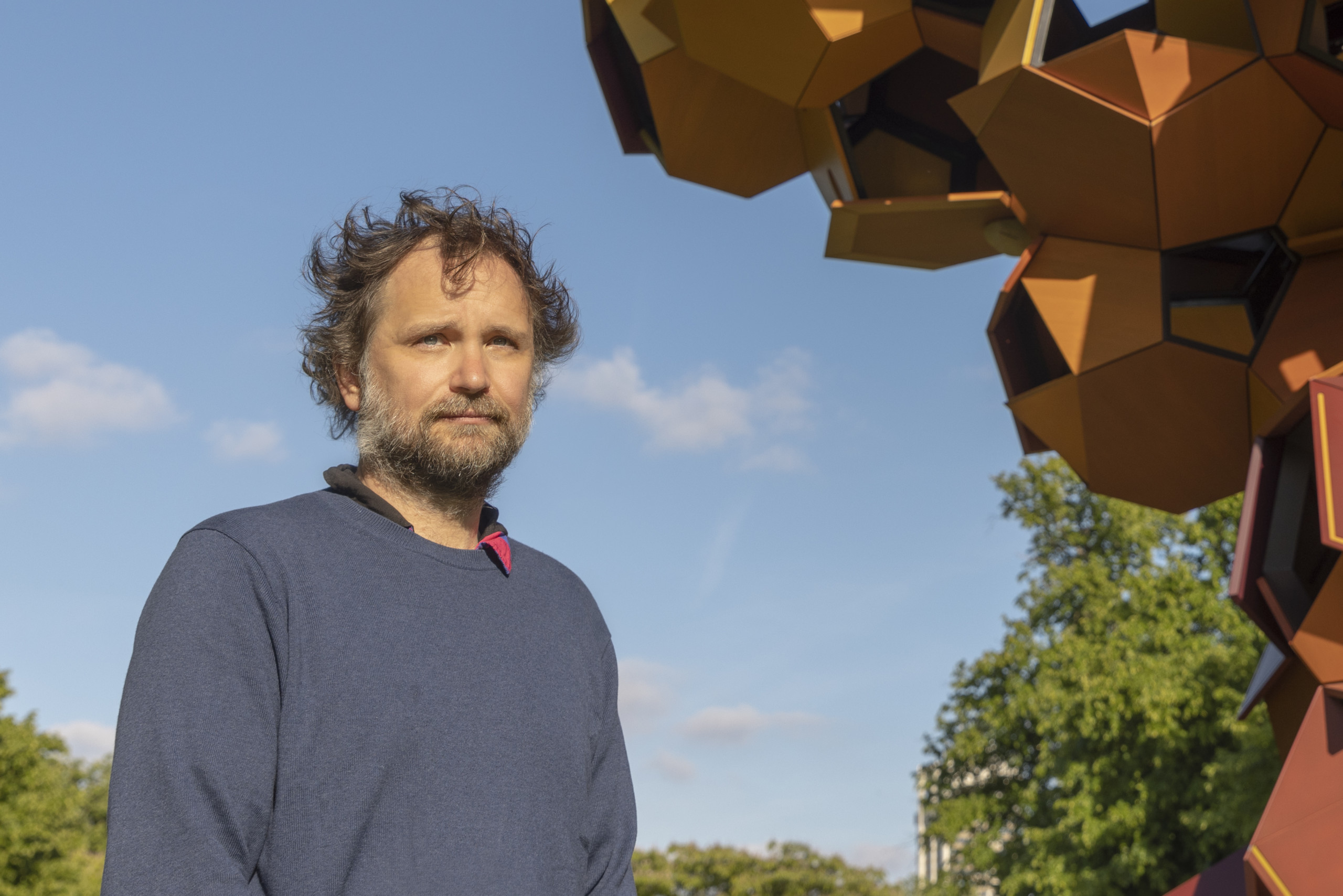Tomás Saraceno was born in Argentina in 1972. Head of an independent laboratory of artistic and scientific experimentation, the artist talks to us about his projects and his environmental commitments.
With a research department devoted entirely to the “Arachnophilia”* project, the Studio Tomás Saraceno pulls us into the world of spiders and their webs, probing their most intimate sounds. The waves produced by these spiders produce a musical score unknown to man. Do you think they communicate with us?
Whether we manage to receive their message or not, they definitely communicate. Spiders are among the earliest inhabitants of our planet, evolving about 400 million years ago. Humans, by comparison, have lived on Earth for a mere 200,000 years. This is the simplest way to express why I think it is important to listen to the spiders, and to have respect for how deeply embedded they are in the web of life. They are their web, they experience the world through it, and use it in highly-sophisticated ways to communicate, sending vibrations through it. Over the last few years, the Arachnophilia department of the studio has been active in developing the emerging scientific field of biotremology in order to learn more about this form of communication. If you think about it, the spiderweb functions as both a nest, hunting trap and string instrument, and so many other things we can not yet even imagine – it’s incredible!
Does the work ArachnoAnacróArcano pay a tribute to the multiplicity of purposes of these spiders’ webs?
The work consists of a repurposed Catholic confessional that replaces the priest with a spider web. Visitors are then invited to come inside it. Integrated shakers within the web produce non audible frequencies that visitors can feel as haptic vibrations. Historically, many humans have placed so much faith and authority in the abstract idea of God being both human, animal and so much more. With this work, we wanted to encourage people to try to access this idea through gaining a closer understanding of the language and the wisdom that is all around us on Earth. Ancestral wisdom is still present in many human cultures, including the spider diviners in Somié, Cameroon, who practice the art of ŋgam dù. In this divination, by interpreting the spider’s answers given through a set of cards and procedures, we can speculate on questions about the future. This is an ancient practice in Cameroon and it is amazing to see how the diviners have learned to understand the language of the spiders! Working together with them, we built nngamdu.org, an online portal made at the request of diviner Bollo Pierre ‘Tadios’, through which they receive 100% of the fee paid for their services.

World(ing)WideWeb(s).Life, 2023. Installation view at Tomás Saraceno In Collaboration: Web(s) of Life, Serpentine, London, 2023. Courtesy the artist. Photography by Studio Tomás Saraceno
Could you explain your Aerocene project and the many forms it takes?
Aerocene started from my love of flying, and my sadness at seeing how our habit of travelling in aeroplanes is destroying the Earth. Therefore, for over twenty years I have been developing other ways of flying that don’t require fossil fuels, but instead rely solely on the sun, the air and a spirit of community and collaboration. It is an ever-growing research and experimental practice whose open-source projects are realised by a dedicated and diverse global community of interdisciplinary practitioners. These communities collaborate to promote and enact experiments around environmental awareness and atmospheric sensing, by imagining new infrastructures of planetary mobility and ethics. By collaboratively developing, testing and launching aerosolar sculptures, Aerocene seeks to open up our imagination towards an emergent cloudscape, un-tethering a new era of planetary attunement, free from borders and fossil fuels. The Aerocene community is active in the airspace of 126 cities, 43 countries and 6 continents, and has floated 7,060 minutes in the air without carbon during 110 tethered flights, 15 free flights, and 8 human flights. As a global community, Aerocene conducts human flights, launches aerosolar sculptures, and organises and participates in art fairs, festivals, workshops, conferences and environmental activism.
In Jujuy, in Argentina, in January 2020, the aerosolar sculpture Aerocene Pacha rose using only the air and the sun, completely free from fossil fuels, batteries, lithium, helium, and hydrogen, becoming the most sustainable flight in human history. This journey set 32 world records, recognised by the Fédération Aéronautique Internationale (FAI), with the Aerocene pilot Leticia Noemi Marques. But most importantly, a message was raised into the air that read: “Water and life are worth more than lithium”, written by the local indigenous communities of Salinas Grandes and Laguna de Guayatayoc, who are fighting to protect their ancestral lands from lithium extraction.
With Aerocene, are your works tending towards activism?
Fundamentally, I believe Aerocene has a strong political message because it acts against fossil fuels. But its political engagement has also grown and become more direct in recent years. After all, anything that flies in the air is highly visible – being an artist also means being visible – so why shouldn’t we use that? I originally came to the salt plains of Jujuy in my homeland Argentina because it is perfect for aerosolar flying: it is completely flat, and the reflection of the sun on the bright white ground makes for ideal conditions. It’s a truly spectacular place. But when I went there, I realised something else was going on too. Local communities are fighting against the extraction of lithium on their lands, which is draining the ground water and forcing them out of their homes. We understood that our causes are related, and that’s why the message we put on Aerocene Pacha was from those indigenous communities. We’ve since gone back, flown more balloons, and arranged symposia and panel discussions in Jujuy and in London to raise awareness about the issue. We dedicated the second issue of the Aerocene Newspaper to the cause, and I even hand-delivered a message from these communities to the Pope, asking him to consider their plea.

Fly with Pacha, Into the Aerocene, 2017—2023 (ongoing). Video still during screening at Tomás Saraceno In Collaboration: Web(s) of Life, Serpentine, London, 2023. Courtesy the artist. Photography by Studio Tomás Saraceno.
Could you tell us about the manifesto you’ve made public, which reflects your commitment to the peoples of the South?
One of the key documents which has informed much of my recent work is the seminal Manifesto for an Eco-social Energy Transition by the Peoples of the South, which outlines an invaluable set of steps that the Global North needs to adhere to, enabling us to shrink our economies and reject the false solutions of the “green transition”. We are often told that this transition is the key to achieving ‘net zero’ carbon emissions, but this approach falls into the old trap of energy colonialism. For instance, the lithium that is extracted in Jujuy goes into electric car batteries, often celebrated as a solution to global warming, that doubles as a lucrative business model, and allows us to continue to drive around in private cars. Moreover, it is destroying the environment in these places, and the lives of the local people. We include the manifesto in the exhibitions wherever possible, in order to raise awareness and to collect signatures. Extracting one ton of lithium requires 2 million litres of water, and this extraction is having a devastating effect on the indigenous communities who inhabit the so-called “lithium triangle” between Argentina, Chile and Bolivia. Much of Aerocene’s work, as documented in ‘Fly with Pacha, into the Aerocene’ (2017-2023 ongoing) documents our collaboration and friendship with the indigenous communities of Salinas Grandes and Laguna de Guayatayoc. Indigenous communities make up 5% of the global population but care for 80% of Earth’s biodiversity. They already know how to live sustainably, but instead of listening to them, the Global North opts for “tech-solutionism” and “Green capitalism”, only finding new ways to destroy the earth and further increasing its ecological debt. As Jason Hickels writes in Less is More: How Degrowth Will Save the World, in the United States and the European Union, less than 1% of lithium batteries are recycled, and 80% of the “technological waste” generated in the North has been sent to countries in the South, exacerbating the climate crisis and inequalities. In a fair and eco-social energy transition, the North’s socio-ecological debt must be recognized.
How can we make an impact today with this manifesto or Aerocene?
As an artist I am privileged in being able to bring the political struggles that I care about into central locations that are visited by a lot of people, such as at the Serpentine Galleries in London or The Shed in New York. I try to share this space as much as possible, by bringing in, for instance, ŋgam dù practitioners as collaborators, and by using the exhibitions to distribute the Aerocene Newspaper and collect signatures for the Eco Social Manifesto and the petition against lithium extraction. In general, the notion of collaboration is central to the practice and emphasising that we never work or exhibit alone, but always together and in concert with the spiders in the basement and the weather outside. To this end, we are developing a new partial common-ownership model that breaks with the idea that an artwork can be the property of a single collector. Instead it writes into the contract how certain works, like our sculptures ‘Cloud Cities: Spaces for Species’ and ‘Other Pieces’, are also owned by the animals that use them, and need to be respected. As privileged as some artists are in terms of access and visibility, many are as disadvantaged when it comes to making direct political impact. I try to support as much as I can, for instance, the communities in their struggle against lithium extraction in Argentina, and the various organisations across the Global South lobbying for an Eco-Social Transition.
*This department has been consisting of research and practices in the fields of biomateriomics, bioacoustics, ethology and cognitive science, among others, as a way of engaging speculatively, but also sensitively, with the forms of life that exist all around us. It is based in Berlin at the Tomás Saraceno studio.
Conversation with Juliette Soulez
December 2023
Learn more about Tomás Saraceno
Learn more about Arachnophilia
Learn more about Aerocene
Cover :Tomás Saraceno. Portrait taken during Tomás Saraceno in Collaboration: Web(s) of Life, Serpentine, London, 2023. Courtesy the artist. Photography by Dario J Laganà.
Impact Art News, November-December 2023 #46

